The current model of drug control relies primarily on law enforcement to seize drugs and imprison drug offenders. While these efforts have produced large numbers of arrests, incarcerations and seizures, drug overdose deaths have increased 540% since 1980 and drug-related problems have worsened:1 emergency room visits, adolescent drug use, and the spread of disease (particularly AIDS and hepatitis) have also risen substantially and drug-related crime continues at high levels. In an effort to minimize drug-related crime, illness and death, the Effective National Drug Control Strategy advocates a policy which emphasizes public health approaches to drug control.


How many people must we incarcerate for current drug policy to work?Figure 1 Sources: Bureau of Justice Statistics. Trends in US Correctional Populations, 1995. US Department of Justice; National Institute on Drug Abuse. Data from the Drug Abuse Warning Network (DAWN): Annual Medical Examiner Data, [1981-1991]; Substance Abuse and Mental Health Services Administration. Data from the Drug Abuse Warning Network (DAWN): Annual Medical Examiner Data, [1992-1997].
The drug war has succeeded in arresting and incarcerating large numbers of people. There are over 1.7 million Americans behind bars. As of June 1996, 5.5 million Americans were under some form of control by the justice system. This translates into 1 out of every 35 adults in the nation.2 According to the Department of Justice, 85% of the increase in the federal prison population from 1985 to 1995 was due to drug convictions.3 Figure 1 illustrates the massive expansion of drug offenders in the jail and prison population, which has increased nearly 12-fold from 1980 to 1995, and a strikingly similar rise in drug overdose deaths over the same period. The graph cannot express the financial and psychological damage endured by the children and spouses of those incarcerated. Nor does it express the damage that certain communities and racial groups experience. For example, black males born today have a nearly one in three chance of going to prison.4


Current government policy seeks to prevent children from gaining access to illegal substances. Since 1975, the federal government has been asking high school seniors how easy it is for them to obtain marijuana. Illustrated by Figure 2 on the left, adolescents' access to marijuana is virtually unchanged by the drug war. In 1975, 87% of youths said it was “very easy” or “fairly easy” to obtain marijuana. Twenty-three years and millions of arrests later, 89.6% said it was easily obtained. Has the drug war succeeded in reducing adolescents' access to drugs?
Since 1992, federal surveys show there has been a rise in adolescent drug use. This has coincided with record spending, record arrests and record incarceration rates. The drug war has escalated for decades, but has not resulted in less adolescent drug use.
Drug crimes receive some of the most severe criminal sanctions in our legal system. Based on federal surveys and by definition of state and federal law, more than 50% of all high school seniors are drug criminals who should be imprisoned. Is this a realistic or appropriate approach to controlling juvenile drug use? If not, then why should only some be arrested?
The current model of youth drug control essentially relies on the random chance of arrest, coupled with an increasing use of locker searches, drug-sniffing dogs, and “just say no” television ads to reduce adolescent drug use. These are unsophisticated approaches to youth drug use that are not based on strategies proven to work. The evidence shows that these strategies have not decreased the availability of drugs for school-aged kids, nor has it deterred their use of drugs.
Does the current drug control strategy reduce the supply of drugs and raise their price?
Strategy. Table 20.

Strategy. Table 20.

The indicators of a successful supply-reduction effort are rising drug prices and decreasing drug purity levels.5 Using data supplied by the ONDCP (Office of National Drug Control Policy), it is clear that the price of heroin has instead dropped significantly over time, while its production has risen greatly. The price of cocaine has similarly dropped from $275.12 per gram in 1981 to $94.52 in 1996.
Despite massive investments in border patrols, overseas crop eradication efforts, Department of Defense involvement and arrests of drug smugglers and drug dealers, the drug war has not reduced the supply of drugs nor made them more costly to obtain.
The market prices for illegal drugs follow the same laws of supply and demand that apply to all commodities. The drug war creates an artificially high commodity price, and these huge profit margins have encouraged more drug producers to enter the market. Greater production has created economies of scale. Lower production costs allow drug cartels to earn the same high profit margins with lower retail prices. The cartels accommodate for interdiction efforts by over-producing their commodity to account for the losses. Since a kilogram of raw opium has been reported to sell for $90 in Pakistan, but is worth $290,000 in the United States, law enforcement seizures at our borders have very little impact on cartel operations or profitability.6
Does the current strategy protect public health?Easy availability, increased purity and lowered prices have resulted in high levels of overdose deaths and hospital emergency room drug episodes. Figure 6 illustrates the steady rise in emergency room drug episodes as recorded by the Drug Abuse Warning Network (DAWN).
Even more alarming has been the devastating expansion of the HIV and Hepatitis C epidemics due to the prohibition on needle possession. Sharing of needles is an engine for the spread of HIV and Hepatitis C. Each day 33 more people are infected with HIV due to injection drug use.7 The epidemics have been particularly onerous on African-American and Latino communities. By the end of 1997, it was estimated that more than 110,000 African-Americans and 55,000 Latinos were living with injection-related AIDS or had already died from it.8
These facts make it hard to avoid the conclusion that the current model of drug control: 1) does not reduce adolescent drug use; 2) does not reduce the supply of drugs; 3) does not reduce the harm caused by drugs.
It is time to develop a drug strategy that works.
Since we are failing to reduce the supply and use of drugs, while incarcerating record numbers of drug offenders, we need to accept that criminal laws cannot effectively solve the complex issue of drug use. Indeed, there is mounting evidence that the extreme criminal sanctions we employ today may actually worsen some of the problems of drug abuse. The Effective National Drug Control Strategy provides a detailed alternative model of drug control based on sound research and empirical evidence, and was developed by a wide range of professional associations. The Effective Strategy emphasizes public health approaches, investment in our children and confronting the underlying economic and social problems, which are the root causes of drug abuse. As can be seen from the chart below, the Effective Strategy seeks to balance law enforcement, treatment and prevention efforts. As this strategy takes effect we expect that law enforcement's role in drug enforcement can be reduced further. We urge that five years after implementation, the policy be evaluated and a longer term strategy be developed.

2 Bureau of Justice Statistics. (1997, August 14). Nation's probation and parole population reached almost 3.9 million last year. Press Release. Washington, DC: Department of Justice.
3 Bureau of Justice Statistics. Prisoners in 1996. Washington, DC: Department of Justice.
4 Bureau of Justice Statistics. (1997, March). Lifetime Likelihood of Going to State or Federal Prison. p. 1. Washington, DC: Department of Justice.
5 ONDCP. (1998). Performance Measures of Effectiveness. Washington, DC. p. 13.
6 Associated Press. (1997, June 26). "U.N. estimates drug business equal to eight percent of world trade."
7 Day, Dawn. Health Emergency 1999: The Spread of Drug-Related AIDS and Other Deadly Diseases Among African-Americans and Latinos. (1998). The Dogwood Center, p. 5.
8 Day, Dawn. (1998). pp. 1, 4.
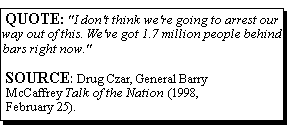 Rationale:
For years U.S. drug policy has taken the approach of arresting anyone who can be connected
with illegal drugs, and has gotten the same results – death, disease, violence and
increasing adolescent drug use. It is time for a critical review of drug policy, not annual
plans that promise more of the same. We need to recognize that the War on Drugs is a
simplistic, politically motivated approach to a complicated health and social phenomenon.
We need to develop a strategy based on more effective approaches.
Rationale:
For years U.S. drug policy has taken the approach of arresting anyone who can be connected
with illegal drugs, and has gotten the same results – death, disease, violence and
increasing adolescent drug use. It is time for a critical review of drug policy, not annual
plans that promise more of the same. We need to recognize that the War on Drugs is a
simplistic, politically motivated approach to a complicated health and social phenomenon.
We need to develop a strategy based on more effective approaches.
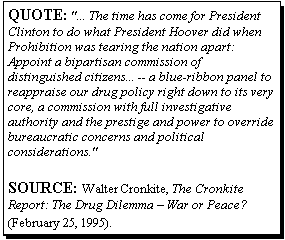 The War on Drugs is approaching a century in length, having been initiated in 1914
with the Harrison Narcotics Act. The drug war gets more expensive each year – the
1999 federal budget of $17.1 billion is a record and is several times larger than the
$3.6 billion appropriated in 1988. States and local governments spend an additional $20
billion annually.
The War on Drugs is approaching a century in length, having been initiated in 1914
with the Harrison Narcotics Act. The drug war gets more expensive each year – the
1999 federal budget of $17.1 billion is a record and is several times larger than the
$3.6 billion appropriated in 1988. States and local governments spend an additional $20
billion annually.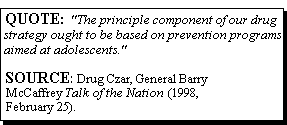 Rationale: Our nation should focus its efforts on fact-based education as
well as programs to dissuade adolescents from the use of alcohol, tobacco and illegal drugs.
Rationale: Our nation should focus its efforts on fact-based education as
well as programs to dissuade adolescents from the use of alcohol, tobacco and illegal drugs.


 According to SAMHSA, “alcohol and drug use tends to be a chosen activity engaged in
during unstructured and unsupervised
time.”
According to SAMHSA, “alcohol and drug use tends to be a chosen activity engaged in
during unstructured and unsupervised
time.” 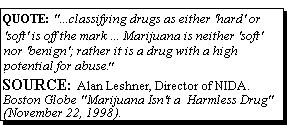 Education is a key component of any plan to change self-destructive behavior. In order for
it to be effective and not undermine its purpose, education must be completely factual and
rational. By relying on scare-tactics and unfounded assertions, the current drug policy has
failed to achieve its purpose. Nowhere can this be more clearly seen than where exaggerated
claims about marijuana lead youth and young adults to disbelieve information about harder
drugs as
well.
Education is a key component of any plan to change self-destructive behavior. In order for
it to be effective and not undermine its purpose, education must be completely factual and
rational. By relying on scare-tactics and unfounded assertions, the current drug policy has
failed to achieve its purpose. Nowhere can this be more clearly seen than where exaggerated
claims about marijuana lead youth and young adults to disbelieve information about harder
drugs as
well.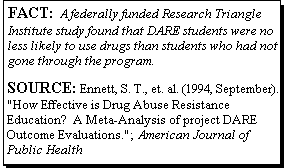 Support for the DARE (Drug Abuse Resistance
Education)
Support for the DARE (Drug Abuse Resistance
Education)
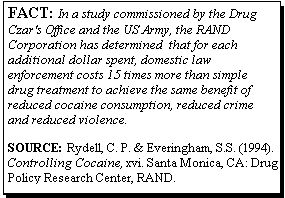 With so much talk by Congress and the White House about the damage that drugs cause our
society, one would think our drug-treatment facilities were wide-open, and eagerly awaiting
patients who have finally heeded the calls of our government to break their addiction.
Not so. An addict can wait many months between a request for treatment and the availability
of a treatment slot. A policy that chooses to provide prison cells rather than treatment beds
makes a mockery of its claims to have a strategy to decrease drug use in America.
With so much talk by Congress and the White House about the damage that drugs cause our
society, one would think our drug-treatment facilities were wide-open, and eagerly awaiting
patients who have finally heeded the calls of our government to break their addiction.
Not so. An addict can wait many months between a request for treatment and the availability
of a treatment slot. A policy that chooses to provide prison cells rather than treatment beds
makes a mockery of its claims to have a strategy to decrease drug use in America.
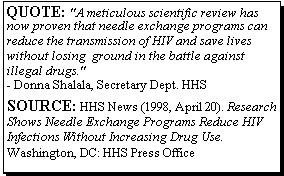 Rationale: As surprising as it may seem, many criminal laws to control
drug use actually work against vital public health goals, such as the suppression of
AIDS/HIV and Hepatitis-C. Clearly, any policy that sacrifices the health and well being
of the entire community by spreading deadly communicable diseases in an effort to
“send the right message” needs to be amended so that it does not cause greater
damage to society than the drug use itself.
Rationale: As surprising as it may seem, many criminal laws to control
drug use actually work against vital public health goals, such as the suppression of
AIDS/HIV and Hepatitis-C. Clearly, any policy that sacrifices the health and well being
of the entire community by spreading deadly communicable diseases in an effort to
“send the right message” needs to be amended so that it does not cause greater
damage to society than the drug use itself.
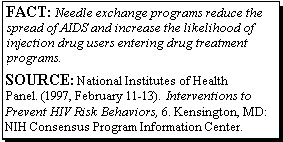 While opponents claim that needle exchange programs “send the wrong
message,” the U.S. Government has funded seven reports on clean needle
programs for persons who inject drugs, and each of the reports concluded
that clean needle programs reduce HIV transmission and do not increase drug
use. The reports were conducted by the National Commission on AIDS, the
General Accounting Office, the University of California, the Centers for
Disease Control, the National Research Council, the Institute of Medicine,
the Office of Technology Assessment, and the National Institutes of Health
Consensus Panel. In fact, Baltimore's Health Commissioner Peter Bielenson,
has found that instead of “sending the wrong message,” quite the
opposite is true as stated in his testimony before Congress:
While opponents claim that needle exchange programs “send the wrong
message,” the U.S. Government has funded seven reports on clean needle
programs for persons who inject drugs, and each of the reports concluded
that clean needle programs reduce HIV transmission and do not increase drug
use. The reports were conducted by the National Commission on AIDS, the
General Accounting Office, the University of California, the Centers for
Disease Control, the National Research Council, the Institute of Medicine,
the Office of Technology Assessment, and the National Institutes of Health
Consensus Panel. In fact, Baltimore's Health Commissioner Peter Bielenson,
has found that instead of “sending the wrong message,” quite the
opposite is true as stated in his testimony before Congress:


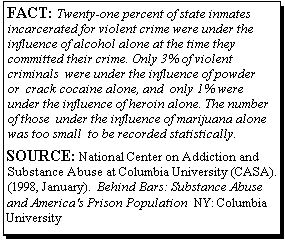 A recent study by the National Center on Addiction and Substance Abuse at Columbia University
(CASA), entitled Behind Bars: Substance Abuse and America's Prison Population,
indicates that only 3% of violent criminals in state prisons were under the influence of
crack or powder cocaine at the time their crime was committed, and only 1% were under the
influence of heroin. In jails, none of the violent criminals was under the influence
of heroin at the time their crime was committed. These facts indicate that our policy makers
need to become more sophisticated in their approach to crime and violence, if we are ever to
see a meaningful reduction in these social ills.
A recent study by the National Center on Addiction and Substance Abuse at Columbia University
(CASA), entitled Behind Bars: Substance Abuse and America's Prison Population,
indicates that only 3% of violent criminals in state prisons were under the influence of
crack or powder cocaine at the time their crime was committed, and only 1% were under the
influence of heroin. In jails, none of the violent criminals was under the influence
of heroin at the time their crime was committed. These facts indicate that our policy makers
need to become more sophisticated in their approach to crime and violence, if we are ever to
see a meaningful reduction in these social ills.

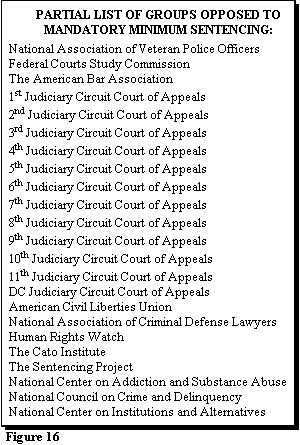
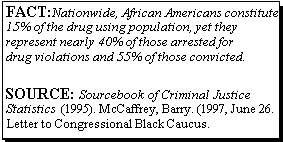 By deciding how much of a drug to charge to a particular defendant, prosecutors can essentially
determine what their sentence will
be.
By deciding how much of a drug to charge to a particular defendant, prosecutors can essentially
determine what their sentence will
be.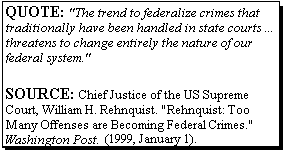 The federal government has developed a national criminal code that results in many cases
being handled by federal courts which should be handled by local courts. With regard to drug
prosecution, the power of federal prosecutors has been so greatly increased that prosecutors
play a larger role in administering justice than judges in drug
cases.
The federal government has developed a national criminal code that results in many cases
being handled by federal courts which should be handled by local courts. With regard to drug
prosecution, the power of federal prosecutors has been so greatly increased that prosecutors
play a larger role in administering justice than judges in drug
cases.
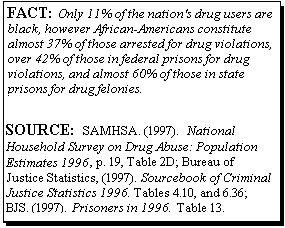 Rationale:
Current laws regarding mandatory minimum sentencing contain documented biases against
minority groups at each stage in the criminal justice process – arrest, prosecution
and sentencing. The negative impacts of these laws have had a devastating effect on black
and Latino populations and must be
changed.
Rationale:
Current laws regarding mandatory minimum sentencing contain documented biases against
minority groups at each stage in the criminal justice process – arrest, prosecution
and sentencing. The negative impacts of these laws have had a devastating effect on black
and Latino populations and must be
changed.

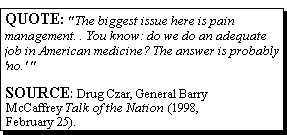 As stated by ONDCP Director Barry McCaffrey, we are not doing enough to help the millions of Americans who suffer from chronic pain. The restrictions for prescribing Schedule 2 drugs like morphine are so strong, and the penalties so great, that doctors consistently under-prescribe pain medication to those who need it most. In 1998, Rep. Henry Hyde introduced the Lethal Drug Abuse Act of 1998, which would have given the Drug Enforcement Administration the power to revoke the prescription license of any doctor who intentionally prescribes a lethal dose of pain medication to a patient. Such a law can only have a chilling effect on the type of pain alleviation doctors will be willing to provide. Giving greater freedom to doctors will allow them to prescribe drugs that work to those in need.
As stated by ONDCP Director Barry McCaffrey, we are not doing enough to help the millions of Americans who suffer from chronic pain. The restrictions for prescribing Schedule 2 drugs like morphine are so strong, and the penalties so great, that doctors consistently under-prescribe pain medication to those who need it most. In 1998, Rep. Henry Hyde introduced the Lethal Drug Abuse Act of 1998, which would have given the Drug Enforcement Administration the power to revoke the prescription license of any doctor who intentionally prescribes a lethal dose of pain medication to a patient. Such a law can only have a chilling effect on the type of pain alleviation doctors will be willing to provide. Giving greater freedom to doctors will allow them to prescribe drugs that work to those in need.
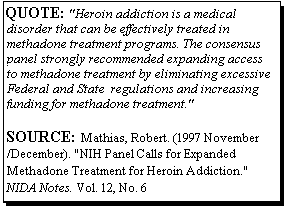 Methadone is the safest, most effective and least costly method to treat heroin addiction, yet it remains a strictly controlled method of treatment. For every 10 heroin addicts in America, there are only one or two methadone treatment slots. We must expand opiate agonist treatment facilities so that every heroin addict can obtain treatment on demand.
Methadone is the safest, most effective and least costly method to treat heroin addiction, yet it remains a strictly controlled method of treatment. For every 10 heroin addicts in America, there are only one or two methadone treatment slots. We must expand opiate agonist treatment facilities so that every heroin addict can obtain treatment on demand.
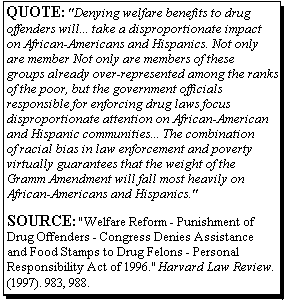
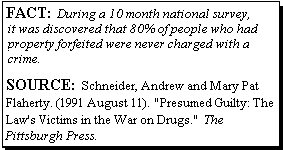 In 1997, the DEA seized $552 million in assets, and the US Customs Service seized $1.65
billion in
assets.
In 1997, the DEA seized $552 million in assets, and the US Customs Service seized $1.65
billion in
assets.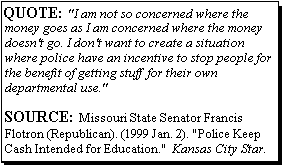 In an effort to prevent this type of conflict of interest, Missouri state law requires that
all seized assets be used to improve public education in the state. This removes the
temptation to abuse forfeiture powers and relieves taxpayers of the burden of education
costs. Unfortunately, police in that state have consistently thwarted attempts to implement
the law by giving seized assets to the DEA, which then returns the money to the police
agencies after retaining a 20% “processing fee.” In a 1999 five-part series,
the Kansas City Star investigated 14 cases of asset forfeiture where law enforcement
agencies seized $1.4 million and sent it to federal agencies, for return after paying
processing fees. In a 1998 ruling on such a case, the judge stated “By summoning the
DEA agent and then pretending DEA made the seizure, the DEA and Missouri Highway Patrol
successfully conspired to violate the Missouri Constitution,… the Missouri Revised
Codes, and a Missouri Supreme Court
decision.”
In an effort to prevent this type of conflict of interest, Missouri state law requires that
all seized assets be used to improve public education in the state. This removes the
temptation to abuse forfeiture powers and relieves taxpayers of the burden of education
costs. Unfortunately, police in that state have consistently thwarted attempts to implement
the law by giving seized assets to the DEA, which then returns the money to the police
agencies after retaining a 20% “processing fee.” In a 1999 five-part series,
the Kansas City Star investigated 14 cases of asset forfeiture where law enforcement
agencies seized $1.4 million and sent it to federal agencies, for return after paying
processing fees. In a 1998 ruling on such a case, the judge stated “By summoning the
DEA agent and then pretending DEA made the seizure, the DEA and Missouri Highway Patrol
successfully conspired to violate the Missouri Constitution,… the Missouri Revised
Codes, and a Missouri Supreme Court
decision.”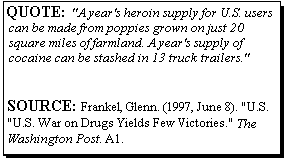 Due to the massive flow of goods and people across our borders, and the small quantities
of drugs that are needed to make enormous profits, interdiction efforts are truly like
searching for a needle in a haystack. One of the major problems with supply reduction
efforts (source control, interdiction, and domestic enforcement) is that “suppliers
simply produce for the market what they would have produced anyway, plus enough extra to
cover anticipated government
seizures.”
Due to the massive flow of goods and people across our borders, and the small quantities
of drugs that are needed to make enormous profits, interdiction efforts are truly like
searching for a needle in a haystack. One of the major problems with supply reduction
efforts (source control, interdiction, and domestic enforcement) is that “suppliers
simply produce for the market what they would have produced anyway, plus enough extra to
cover anticipated government
seizures.”